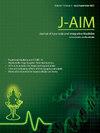探索苦参衍生的天然产物作为结核分枝杆菌泛酸激酶- pank抑制剂的前景:一种集成的计算机和体外方法
IF 1.9
Q3 INTEGRATIVE & COMPLEMENTARY MEDICINE
引用次数: 0
摘要
结核病仍然是一个普遍和持久的全球卫生挑战,耐药变体的数量惊人地增加。结核分枝杆菌(M. tuberculosis)是导致结核病的细菌,它部署了一个复杂的毒力因子库来逃避宿主的免疫防御。寻找新的靶点或化合物来对抗耐药结核分枝杆菌菌株是至关重要的。PanK是辅酶A (CoA)生物合成途径的必需酶,利用藜属植物化学物质靶向抑制其活性可能为抗药菌株提供有效的治疗策略。目的研究从苦参中提取的天然化合物作为结核分枝杆菌PanK酶(新靶点)抑制剂的潜力。方法采用硅计算的方法,对83个紫薇属化合物进行基于步骤-结构的虚拟筛选,然后进行分子对接和100 ns的动态模拟,以评估筛选关键化合物与PanK之间的结合亲和力和稳定性。体外抗结核生物测定也进行了验证硅实验的发现。结果通过硅晶实验,鉴定出了酒藤中的4个关键化合物:-木犀草素A、芦丁、Withaoxylactone和2,3-二氢酒藤内酯E。它们表现出很强的抑制PanK酶活性的潜力。计算机和体外实验结果表明,苦参衍生的天然化合物可以作为靶向结核分枝杆菌重要酶的有效候选物。结论somnifera可作为开发新型抗结核药物PanK的宝贵资源。本文章由计算机程序翻译,如有差异,请以英文原文为准。
Exploring Withania somnifera derived natural products as promising inhibitors of Mycobacterium tuberculosis Pantothenate Kinase-PanK: An integrated in silico and in vitro approach
Background
Tuberculosis remains a pervasive and enduring global health challenge, with the alarming rise of drug-resistant variants. Mycobacterium tuberculosis (M. tuberculosis), bacterium responsible for tuberculosis, deploys a complex arsenal of virulence factors to evade the host’s immune defences. The quest for novel targets or compounds to combat drug-resistant M. tuberculosis strains is of paramount importance. PanK is an essential enzyme for Co-enzyme A (CoA) biosynthesis pathway, targeting inhibition of its activity by Withania somnifera phytochemicals may provide an effective therapeutic strategy against resistant strains.
Objective
The study aims to identify the potential of natural compounds derived from Withania somnifera as inhibitors of the PanK enzyme (novel target) in M. tuberculosis.
Methodology
In silico computational approach, includes steps-structure based virtual screening of 83 Withania compounds followed by molecular docking and dynamic simulations spanning 100 ns, to assess the binding affinity and stability between screen key compounds and PanK. In vitro anti-tuberculosis bioassays was also performed to validate the In silico experiments finding.
Result
Through in silico experiments, four key compounds of Withania somnifera were —Morkotin A, Rutin, Withaoxylactone, and 2,3-Dihydrowithanolide E were identified. They exhibited strong potential to inhibit PanK enzyme activity. The In silico as well as In vitro findings suggest that Withania somnifera-derived natural compounds could serve as effective candidates for targeting vital enzymes in M. tuberculosis.
Conclusion
Withania somnifera can be explored as valuable resource for developing novel drugs for PanK as a target to combat tuberculosis.
求助全文
通过发布文献求助,成功后即可免费获取论文全文。
去求助
来源期刊

Journal of Ayurveda and Integrative Medicine
INTEGRATIVE & COMPLEMENTARY MEDICINE-
CiteScore
4.70
自引率
12.50%
发文量
136
审稿时长
30 weeks
 求助内容:
求助内容: 应助结果提醒方式:
应助结果提醒方式:


